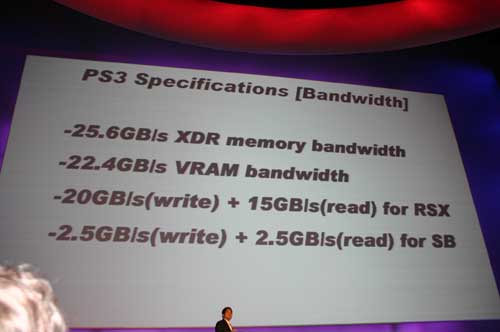E3 2005 - Day 2: More Details Emerge on Console GPUs
by Anand Lal Shimpi on May 19, 2005 1:24 PM EST- Posted in
- Trade Shows
Scratching the Surface of NVIDIA's RSX
As we mentioned before, NVIDIA's RSX is the more PC-like of the two GPU solutions. Unlike ATI's offering, the RSX is based on a NVIDIA GPU, the upcoming G70 (the successor to the GeForce 6).
The RSX is a 90nm GPU weighing in at over 300 million transistors and fabbed by Sony at two plants, their Nagasaki plant and their joint fab with Toshiba.
The RSX follows a more conventional dataflow, with discrete pixel and vertex shader units. Sony has yet to announce the exact number of pixel and vertex shader units, potentially because that number may change as time goes by depending on yields. This time around Sony seems to be very careful not to let too many specs out that are subject to change to avoid any sort of backlash as they did back with the PS2. Given the transistor count and 90nm process, you can definitely expect the RSX to feature more than the 16 pipes of the present day GeForce 6800 Ultra. As for how many, we'll have to wait for Sony on that.
NVIDIA confirmed that the RSX is features full FP32 support, like the current generation GeForce 6 as well as ATI's Xbox 360 GPU. NVIDIA did announce that the RSX would be able to execute 136 shader operations per cycle, a number that is greater than ATI's announced 96 shader ops per cycle. Given that we don't know anything more about where NVIDIA derived this value from, we can't be certain if we are able to make a direct comparison to ATI's 96 shader ops per cycle.
Given that the RSX is based off of NVIDIA's G70 architecture, you can expect to have a similar feature set later this year on the PC. In fact, NVIDIA stated that by the time PS3 ships there will be a more powerful GPU available on the desktop. This is in stark contrast to ATI's stance that a number of the features of the Xbox 360 GPU won't make it to the desktop for a matter of years (potentially unified shader architecture), while others will never be seen on the desktop (embedded DRAM?).
There will definitely be some differences between the RSX GPU and future PC GPUs, for a couple of reasons:
1) NVIDIA stated that they had never had as powerful a CPU as Cell, and thus the RSX GPU has to be able to swallow a much larger command stream than any of the PC GPUs as current generation CPUs are pretty bad at keeping the GPU fed.
2) The RSX GPU has a 35GB/s link to the CPU, much greater than any desktop GPU, and thus the turbo cache architecture needs to be reworked quite a bit for the console GPU to take better advantage of the plethora of bandwidth. Functional unit latencies must be adjusted, buffer sizes have to be changed, etc...
We did ask NVIDIA about technology like unified shader model or embedded DRAM. Their stance continues to be that at every GPU generation they design and test features like unified shader model, embedded DRAM, RDRAM, tiling rendering architectures, etc... and evaluate their usefulness. They have apparently done a unified shader model design and the performance just didn't make sense for their architecture.

NVIDIA isn't saying that a unified shader architecture doesn't make sense, but at this point in time, for NVIDIA GPUs, it isn't the best call. From NVIDIA's standpoint, a unified shader architecture offers higher peak performance (e.g. all pixel instructions, or all vertex instructions) but getting good performance in more balanced scenarios is more difficult. The other issue is that the instruction mix for pixel and vertex shaders are very different, so the optimal functional units required for each are going to be different. The final issue is that a unified shader architecture, from NVIDIA's standpoint, requires a much more complex design, which will in turn increase die area.
NVIDIA stated that they will eventually do a unified shader GPU, but before then there are a number of other GPU enhancements that they are looking to implement. Potentially things like a programmable ROP, programmable rasterization, programmable texturing, etc...
Final Words
We're going to keep digging on both of these GPUs, as soon as we have more information we'll be reporting it but for now it's looking like this is the best we'll get out of Microsoft and Sony.










22 Comments
View All Comments
LanceVance - Thursday, May 19, 2005 - link
"This year's E3 has been, overall, a pretty big letdown"Major new hardware announcements and details from the big three console manufacturers. This is the most exciting E3 that I can remember (I just read about it; never actually been to the show).
Plenty of upcoming titles have been announced and discussed as well. Were the previous E3's way more exciting or is the conference in general just not much more exciting than all the info you can read on the Internet?
knitecrow - Thursday, May 19, 2005 - link
the X360 and PS3 may be even closer in terms of power than anyone thought